|
Lactarius deliciosus
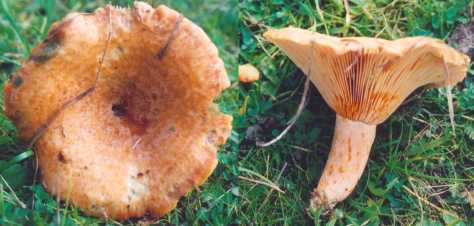
The saffron milk cap is a truly beautiful beast, much prized by some pickers. I find it a trifle bland, and use it in soups
and stews with other mushrooms.
It's a very distinctive mushroom, an inhabitant of pine woods that bleeds carrot
coloured 'milk' when the stem is cut. The cap and gills bruise green when touched.
Volvariella speciosa
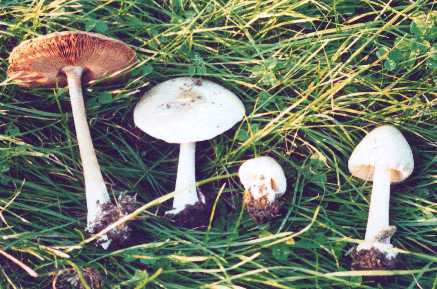
In autumn 2001 this mushroom appeared to be everythere, I picked basket loads! Beautiful mushroom, appeared in patches
all over some local farm fields and at the edge of the woods. Tasty too.
The first batch I picked were drenched in
the rain, and cooked down to make a great soup with some onion, garlic, cream, chicken stock powder and some seasoning. When
I've picked them on drier days they're great with pasta. Although the caps (especially in younger specimens, like the two
on the right) are somewhat viscid, I've been experimenting with drying them and that seems to have worked out fine.
Further pictures and a good description of V. speciosa for comparison can be found here.
http://www.mykoweb.com/CAF/species/Volvariella_speciosa.html
Marasmius oreades
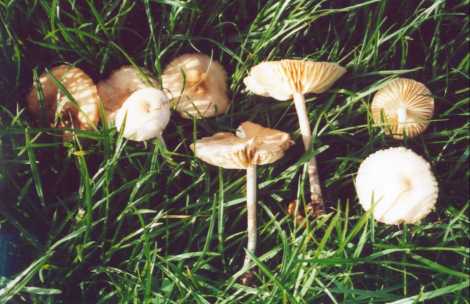
If you ever hear a couple of mushroom fanatics going on about the strange, rare edible mushrooms they've found, and how you
have to go way out of your way to find such delicacies, don't believe them!
This is the common fairy ring mushroom.
It's brownish, smells of almonds, and tastes great. It grows in great big rings in parks and pastures all over the U.K. The
only snag is that it can be mixed up with a rather deadly Clitocybe species if you don't know what you're doing.
That
said, go and get a good guide book to see the difference, and you'll soon have your eye in and be picking loads of these mushrooms.
They grow from late summer to late autumn, with a fresh crop appearing after rain.
Pick them just after that, before
they become infested with maggots. A very versatile, and very tasty mushroom.
Lepista saeva
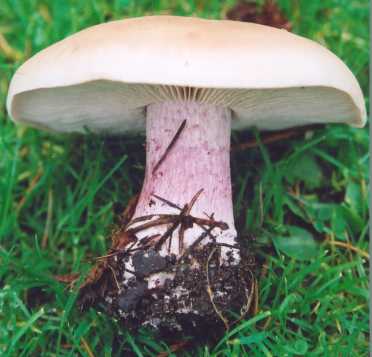
A belting good mushroom this one. A good way to cook it is in the traditional Nottinghamshire way. Probably the most popular wild mushroom in many parts of the Midlands in England, the field blewit (bluey, blue-leg,
bluebutton, etc) can be found growing in large numbers from late summer right through to January or February. Nearly always
free of maggots, this is a strong tasting, meaty mushroom. Try to pick it while dry, because it can absorb more than
its own weight of rain water.
Lepista nuda
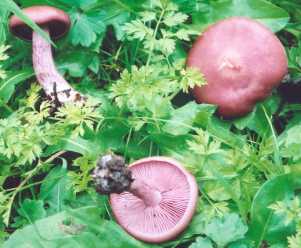
The wood blewit is an highly distinctive mushroom. Beautiful to behold, the purple cap goes brownish as it ages. Like
the field blewit, make sure you cook it well because some people find it a little indigestible raw.
It can be cooked in the same way as the field blewit, with one highly reccomended way of cooking it being Nottingham blewits.
Armillaria mellea
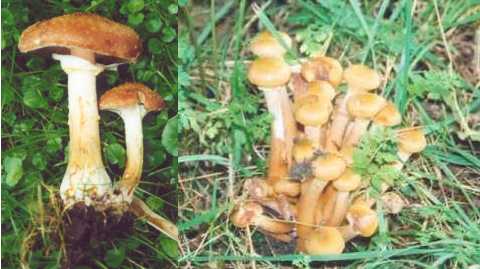
In some places, the parasitic honey fungus (also known as bootlace fungus) is tremendously common. It grows on dead tree stumps,
sending out black rhizomes to attack other trees which will then die. As you'd expect, this fungus is most unwelcome in forestry
plantations and in parks.
The rhizomes themselves are quite fun, if you canfind them on a moonless night. They are
bioluminescent, meaning that they glow.
The mushrooms themselves are perfectly edible once cooked. Very much a mushroom
you'll either love or hate.
Laccaria laccata and Laccaria amethysta
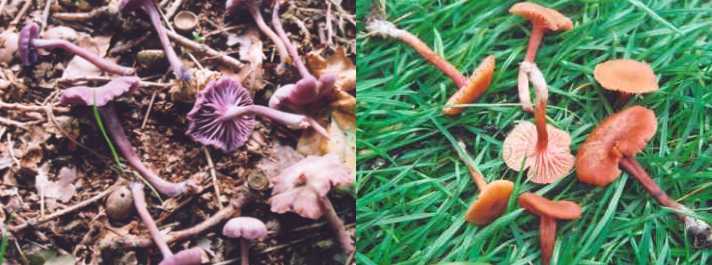
The deceiver (and its relative, the amethyst deceiver) is a common mushroom found on lawns, in parks, and around woodlands.
It is aptly named, because its look can vary greatly (as you can see in the picture).
It's got a pleasant flavour,
and dries well.
Macrolepiota procera and Macrolepiota rhacoides

The parasol (and the shaggy parasol) are among my favourite species of mushroom. Big and tasty, beautiful to see, and
frequently to be found in great big rings. I like to eat them fried in a little olive oil, or in omelettes. They also dries
quite well, sliced up small and go well in mushroom pate. Some people find these a little indigestible, so go easy on your first couple of sittings! Large specimens
can be almost a foot across, but by that stage they'e normally full of maggots. They're therefore best picked a bit younger
than that. Don't be put off by the fact that when you cut the stem, the inside turns a dark red colour. Many mushrooms change
colour in some way when damaged.
Clitocybe odora
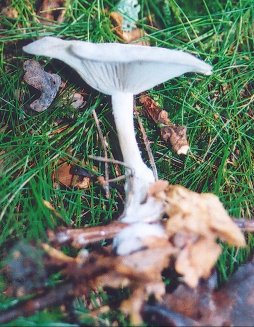
The anise cap (or anise toadstool) is a truly odd entity. Bright blue-green to greyish green, with a strong, aniseed
flavour, this inhabitant of decaying leaf matter is distinctive indeed!
Cook with it with caution, it retains the strong aniseed flavour. I like to dry it and add it to food when that's called
for. It works especially well in Chinese food.
Coprinus comatus
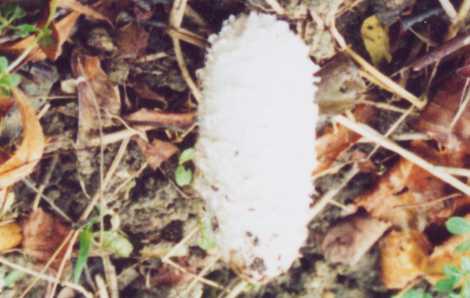
Apologies for the naff quality of the above photo!
This is also a very common mushroom. White, shaggy, colloquially
known as a shaggy cap or lawyers wig, this mushroom makes excellent eating. Has to be young, though, and it has to be eaten
soon after picking. It rapidly turns pink, then black in the gills, and becomes an inky mess in no time at all. It literally
dissolves in it's own enzymes, releasing spores the whole time.
If you're lucky and find lots of them, they make great
soup and are perfect for mushroom ketchup. I've often come home with a whole basket load of these, so keep your fingers crossed.
If you only find a few, try frying them in butter. Very tasty.
Be very careful to avoid confusion with the
common ink cap (toxic if ingested for hours either side of drinking alcohol) and the magpie cap (alledgedly toxic).
Boletus chrysenteron
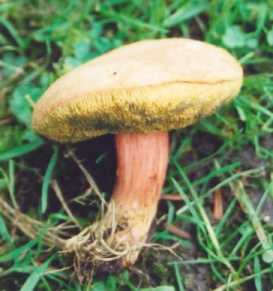
This is probably the most common of the boletes (pore bearing mushrooms) in the U.K. Found in woodlands and parks, in association
with a range of broad leaf and coniferous trees.
It gets up to about 10-12 cm across the cap, often with quite large
pores (1-2mm). When you cut it, it stains faintly blue-green, and the yellow pores bruise a dirty green colour.
Often
a bit squidgy, this one. Best eaten while it's young. I reccomend not making pate from it, as such a dish is invariably a
horrible shade of green.
|




